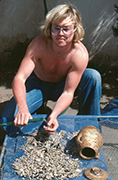|
R E G I S T R Y D A T A B A S E • B O N E
Human & Faunal Remains |
|
|
 |
For the Stager excavations of 1976-79, we have two competing reports. The contents of the urns were wet-sieved by J. H. Schwartz (University of Pittsburgh) during excavations and assigned the prefix X-, with bone normally re-assigned the prefix J-. Although a few preliminary reports had been produced in the three decades following the ASOR Punic Project, no full osteological report appeared. Stager therefore requested the bones be returned from Pittsburgh to the HMANE, where they were then assigned to P. Smith (Hebrew University). As a result, two contradictory reports appeared in quick succession concering the exact same osteological samples, leading to polemical debate ( Schwartz et al. 2010, Smith et al. 2011, cf. Garnand et al. 2013).
Animal bones were noted by Schwartz during initial sieving, but were assigned to B. Hesse, with his analysis completed by P. Hesse and D. Fulton ( 2023). Most urns contained at least a few cremated fragments of juvenile sheep/goat; some held only Ovicaprid remains to the exclusion of juvenile human bones.
sample: D. Dirkmaat wet-sieving urn contents, 1978
©2023 HMANE ASOR Punic Project (G. Wood, unnumbered snapshot)
CT_registry at OpenContext |
|
exhibition goals: ALthough the osteological remains will be central to interpretation of the precinct (and will be the focus of one of the symposia parallel to the exhibition), the infant bones themselves would not be appropriate for display. However, interpretive panels would represent both Homo and Ovicaprid data.
|
|
|
|